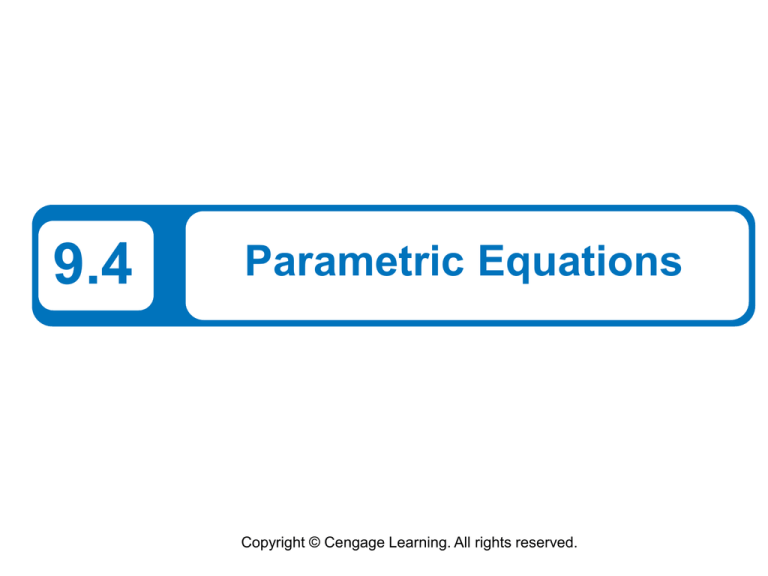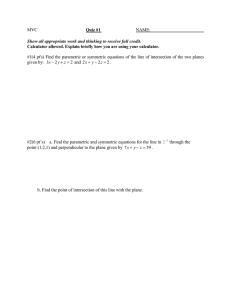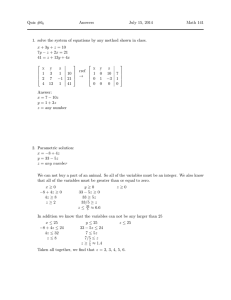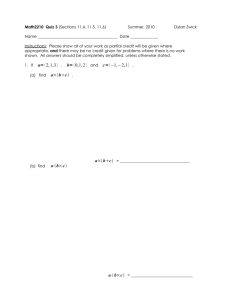
9.4
Parametric Equations
Copyright © Cengage Learning. All rights reserved.
What You Should Learn
•
•
•
•
Evaluate sets of parametric equations for given
values of the parameter
Graph curves that are represented by sets of
parametric equations
Rewrite sets of parametric equations as single
rectangular equations by eliminating the
parameter
Find sets of parametric equations for graphs
2
Plane Curves
3
Plane Curves
Up to this point, you have been representing a graph by a
single equation involving two variables such as x and y.
In this section, you will study situations in which it is useful
to introduce a third variable to represent a curve in the
plane.
To see the usefulness of this procedure, consider the path
of an object that is propelled into the air at an angle of 45.
4
Plane Curves
When the initial velocity of the object is 48 feet per second,
it can be shown that the object follows the parabolic path
Rectangular equation
as shown in Figure 9.42.
Curvilinear motion: two variables for position, one variable for time
Figure 9.42
5
Plane Curves
However, this equation does not tell the whole story.
Although it does tell you where the object has been, it does
not tell you when the object was at a given point (x, y) on
the path.
To determine this time, you can introduce a third variable t,
called a parameter. It is possible to write both x and y as
functions of t to obtain the parametric equations
Parametric equation for x
Parametric equation for y
6
Plane Curves
From this set of equations you can determine that at time
t = 0, the object is at the point (0, 0). Similarly, at time t = 1,
the object is at the point
and so on.
For this particular motion problem, x and y are continuous
functions of t, and the resulting path is a plane curve.
(Recall that a continuous function is one whose graph can
be traced without lifting the pencil from the paper.)
7
Plane Curves
8
Graphs of Plane Curves
9
Graphs of Plane Curves
One way to sketch a curve represented by a pair of
parametric equations is to plot points in the xy-plane.
Each set of coordinates (x, y) is determined from a value
chosen for the parameter t.
By plotting the resulting points in the order of increasing
values of t, you trace the curve in a specific direction. This
is called the orientation of the curve.
10
Example 1 – Sketching a Plane Curve
Sketch the curve given by the parametric equations
x = t2 – 4
and
y=
–2 t 3.
Describe the orientation of the curve.
11
Example 1 – Solution
Using values of t in the interval, the parametric equations
yield the points (x, y) shown in the table.
12
Example 1 – Solution
cont’d
By plotting these points in the order of increasing t, you
obtain the curve shown in Figure 9.43.
Figure 9.43
13
Example 1 – Solution
cont’d
The arrows on the curve indicate its orientation as t
increases from –2 to 3.
So, when a particle moves on this curve, it would start at
(0, –1) and then move along the curve to the point
14
Eliminating the Parameter
15
Eliminating the Parameter
Many curves that are represented by sets of parametric
equations have graphs that can also be represented by
rectangular equations (in x and y). The process of finding
the rectangular equation is called eliminating the
parameter (using substitution).
x = t2 – 4
t = 2y
x = (2y)2 – 4
x = 4y2 – 4
y=
16
Eliminating the Parameter
Now you can recognize that the equation x = 4y2 – 4
represents a parabola with a horizontal axis and vertex at
(–4, 0).
When converting equations from parametric to rectangular
form, you may need to alter the domain of the rectangular
equation so that its graph matches the graph of the
parametric equations. This situation is demonstrated in
Example 3.
17
Example 3 – Eliminating the Parameter
Identify the curve represented by the equations
Solution:
Solving for t in the equation for x produces
18
Example 3 – Solution
cont’d
Substituting in the equation for y, you obtain the
rectangular equation
From the rectangular equation,
you can recognize that the curve
is a parabola that opens downward
and has its vertex at (0, 1), as
shown in Figure 9.54.
Figure 9.54
19
Example 3 – Solution
cont’d
The rectangular equation is defined for all values of x. The
parametric equation for x however, is defined only when
t > –1.
From the graph of the
parametric equations,
you can see that x is always
positive, as shown in
Figure 9.55.
Figure 9.55
20
Example 3 – Solution
cont’d
So, you should restrict the domain of x to positive values,
as shown in Figure 9.56.
Figure 9.56
21
Finding Parametric
Equations for a Graph
22
Finding Parametric Equations for a Graph
You have been studying techniques for sketching the graph
represented by a set of parametric equations.
Now consider the reverse problem—that is, how can you
find a set of parametric equations for a given graph or a
given physical description?
From the discussion following Example 1, you know that
such a representation is not unique.
23
Finding Parametric Equations for a Graph
That is, the equations
x = 4t2 – 4
and
y = t,
–1 t
produced the same graph as the equations
x = t2 – 4
and
y=
–2 t 3.
This is further demonstrated in Example 4.
24
Example 4 – Finding Parametric Equations for a Given Graph
Find a set of parametric equations to represent the graph of
y = 1 – x2 using the parameters
(a) t = x
and
(b) t = 1 – x.
Solution:
a. Letting t = x, you obtain the following parametric
equations.
x=t
Parametric equation for x
y = 1 – t2
Parametric equation for y
25
Example 4 – Solution
cont’d
The graph of these equations is shown in Figure 9.57.
Figure 9.57
26
Example 4 – Solution
cont’d
b. Letting t = 1 – x, you obtain the following parametric
equations.
x=1–t
Parametric equation for x
y = 1 – (1 – t)2 = 2t – t2
Parametric equation for y
27
Example 4 – Solution
cont’d
The graph of these equations is shown in Figure 9.58.
Figure 9.58
28
Example 4 – Solution
cont’d
Note that the graphs in Figures 9.57 and 9.58 have
opposite orientations.
Figure 9.57
Figure 9.58
29




